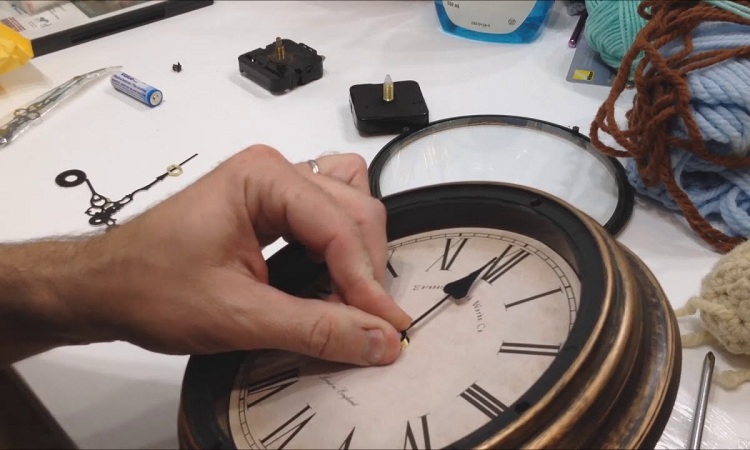Ticking clocks can drive people crazy, especially if they suffer from misophonia. Even if you don’t have a disagreeable problem with sounds, the repetitive sound of a ticking clock can be annoying.
Whether the problem lies with the clock or your aversion to repetitive noises, you’ll want to find out how to silence clock ticking.
Let’s first find out more about why some clocks are so loud before moving onto how to create a serene, less noisy environment.
Why are clocks so loud?

Loudly ticking clocks are annoying at best, especially if they wake you in the middle of the night or disrupt your work at home.
The consensus is that noisy clocks are due to sub-standard materials. When manufacturers use cheaper materials in clock-making, the moving bits tend to clang and grind more than when they use higher-quality parts.
Either the clock is new and contains cheaper materials, or you have something of an heirloom in the home, which needs a little TLC (tender loving care).
Maybe your clock needs a little oiling to reduce its noise levels. Whatever the reason for your loudly ticking clock, there is a way to remedy the situation.
With a few steps, you can restore peace and quiet in your home or office environment and get some good sleep.
What can be done to silence clock ticking?

Other than losing your temper and throwing your clock out the window (or dumpster), you can take action to reduce the decibel level of your loudly ticking clock.
To start your new how to silence clock ticking DIY initiative, you will first need to conduct an elimination process.
Once this elimination action is done and the clock is still clicking at a furious noise level, there are additional steps that you can take to solve the problem.
Go through these five steps on how to silence clock ticking and get your home back to normal.
The elimination process consists of:
- First, oil the clock’s moving parts to get rid of the noise
- Stuff the back of the clock with material to deaden the sound
- Soundproof the insides of the clock
- Replace the clock’s mechanism
- Consider replacing the clock if none of these activities resolve the issue
Some things you’ll need to get the job done include:
- A screwdriver to remove the clock casing may be necessary, depending on the backing the clock has. Depending on how the backing is fixed to the clock, you may need a flat or a star screwdriver
- Oil suitable for lubricating the moving parts of the clock, such as Liberty oil
- A sound-deadening product like Dynamat or liquid foam
- Stuffing such as fabric or cotton wool
- A cutting tool
- Adhesive
- Sturdy cardboard and tape
- You may want to replace the clock mechanism
Start any DIY job at the beginning by using a process of elimination. These five steps guide you through the process of how to silence a clock ticking incessantly to restore tranquility in the home.
Step-by-step guide
Suppose you suffer from misophonia, which is thought to be an increase of fatty deposit around myelin sheaths that increases sensitivity to noise.
In that case, these steps will help you silence your clock. Even if you don’t have misophonia, where some repetitive noises disturb your peace intermittently or regularly, a noisy clock can disrupt concentration and sleep.
These five steps are solutions to overcoming your ticking clock problem. Some will resolve the issue altogether.
Other solutions will reduce the noise of the ticking clock to bearable levels. Which result you achieve from using these steps will largely depend on the type of clock you want to silence.
Step 1: Oil the clock’s moving parts

Your first step towards how to silence a clock ticking and living a peaceful life is to lubricate the moving parts of the clock.
Find the correct tools to remove the back of the clock to gain access to its moving parts. Clock backs are closed in various ways, but many will need a screwdriver with a flat or a star point.
Remove the back of the clock and spray or drip the oil onto all the moving parts. Lubrication should go a long way towards reducing the sound level of the clock’s ticking mechanism.
If you don’t have Liberty oil, choose another thin oil specially designed for clock lubrication as thicker or the incorrect oils can damage the clock’s working parts.
Once you have finished generously lubricating the clock’s insides, replace its backing and check the performance.
If the clock still ticks loudly, it is time to move onto a more permanent solution, such as soundproofing your clock.
Step 2. Stuff the back of the clock
Remove the back of the clock again and place stuffing on the inside. You can use some fabric that is lying around, cut a piece of cloth to size or use cotton wool to soundproof the clock’s insides.
Ensure you avoid the fabric contacting the working parts of the clock’s insides. You can use some tape or adhesive to secure the material in place. Alternatively, you can cut a small cardboard box to size to cover the mechanism before placing the stuffing in the back of the clock.
Close the clock back and test whether there is any noise reduction.
Step 3. Soundproof the inner workings of the clock
After giving yourself (and the clock) some time to demonstrate whether the lubrication or stuffing works and find that it doesn’t–soundproof it.
Remove the back panel of the clock again. Cut a few pieces of Dynamat or a cheaper alternative like B-Quiet or Siless to soundproof your clock.
Cut the soundproofing material to size. Use adhesive to secure the sound deadening matting in place. Close the clock up.
Listen to the clock’s ticking to determine whether the noise is now at a bearable level or otherwise.
If you want to try a different approach–use an appropriate soundproofing liquid.
You can first cover the mechanism with the small box you created in the previous step before spraying the liquid inside the clock.
Step 4: Purchase a new clock mechanism.

If none of your efforts on how to silence a clock ticking have worked–purchase a new clock mechanism. If you are truly attached to your clock, ensure that you buy a quality clock mechanism.
Communicate with the manufacturer or a clock expert and read reviews on the product to ensure that the clock’s mechanism runs quietly.
It will be pointless to purchase a new mechanism only to find yourself back at step one.
Step 5: Purchase a new clock.
Once you have given all these steps a tryout and your clock is still driving you to distraction–it may be time to call it quits. You can give the old clock away or throw it in the trash.
Then go on an in-person shopping adventure to find a clock that ticks quietly.
Make this purchase in person to listen to the ticking volume of the clocks yourself.
Making a clock purchase online could just set you back, and a personal purchase will allow you to speak to a salesperson who can point you to the quietest clocks on the shop floor.
Conclusion
Noisy clock ticking can disrupt your sleep, recreation, and work. You can choose easy methods to reduce the sound of your ticking clock or do a DIY soundproofing job with proper materials.
Give it a try by following the basic steps on how to silence clock ticking with these straightforward steps:
- Oil the clock’s moving parts
- Stuff the back of the clock
- Soundproof the inner workings of the clock
- Purchase a new clock mechanism
- Purchase a new clock
Send us your hints or tips on how to silence clock ticking, or give us your feedback experience if you followed our directions.
Resources:
